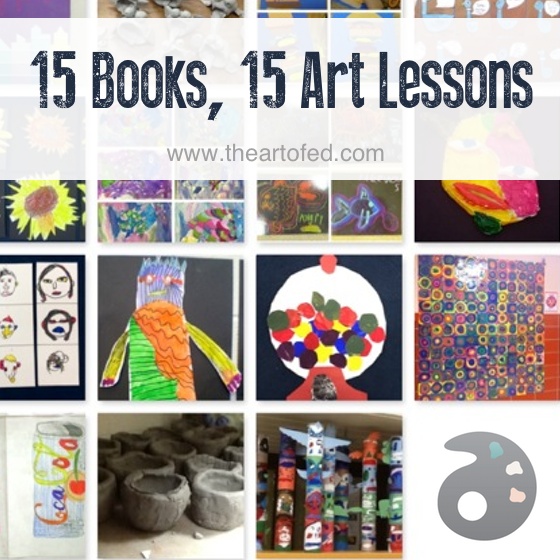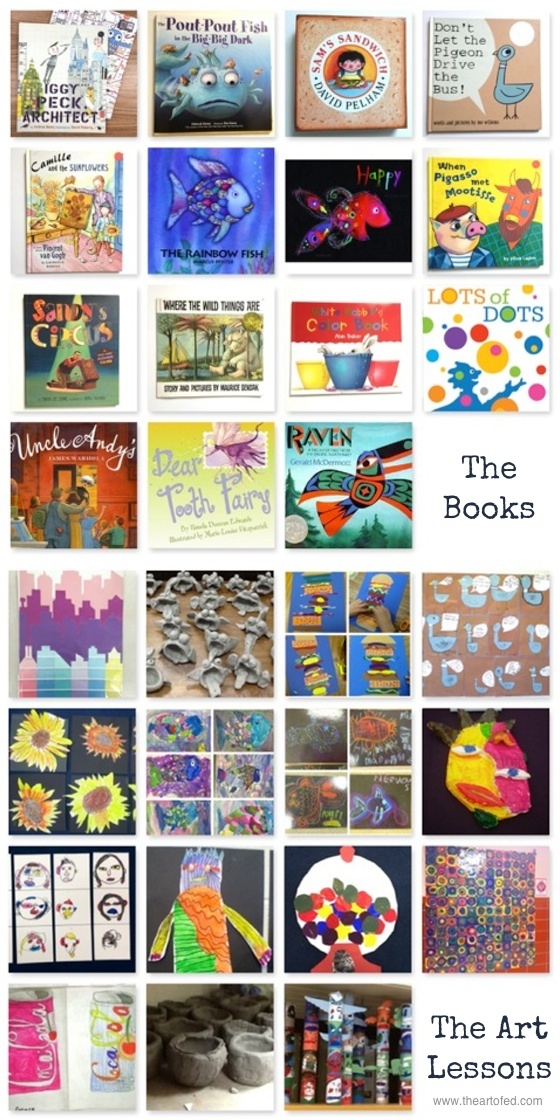I love using books to inspire and supplement art lessons. This fact is especially evident from one of my previous articles 10 Books Every Art Teacher Needs. In addition to the books from that list, I’ve compiled a list of 15 more stories, which each pair with a specific lesson from my elementary curriculum. Of course, this doesn’t even come close to the growing list of the fantastic books and series that can be used in the art room, but I hope it gets you started!

Below each pairing you will see the following abbreviations:
G – Describes the grade level I teach the lesson to, but all of these can be adapted for older or younger students.
O – Lists the lesson objectives
V – Lists any lesson vocabulary and artists as well as the elements and principals for the lesson
Notes – Includes a bit more information about the book and the lesson
1. Iggy Peck Architect by Andrea Beaty & Paint Card Cities
G: 2nd Grade
O: Study the silhouettes and different shapes of a skyline. Understand and create building shapes and skylines in the foreground, middle ground, and background. Observe and create details in nearby objects.
V: architect, silhouette, skyline, foreground, middle ground, background, line, shape, space, color, balance
Notes: This rhyming book is a fun way to introduce students to architecture. While reading, you can point out the shapes and details of all the different buildings. You can also notice how objects in the background and foreground have different levels of detail. (For even more fun, check out Rosie Revere Engineer)
2. The Pout Pout Fish Series by Deborah Diesen & Clay Pinch Pot Pout Pouts (inspired by Art with Mr. E)
G: 2nd Grade
O: Create pinch pots and attach fins and eye balls using the score and slip method. Begin basic understanding of the clay process.
V: pinch pot, score, slip, kiln, glaze, color, form
Notes: I have my students make their own versions of the pout pout character. For reference, as we read, I have the students pay close attention to the details of the fish’s body.
3. Sam’s Sandwich by David Pelham & Sandwich Collage
G: 1st Grade or 2nd Grade
O: Practice cutting and manipulating paper and other 2D materials. Practice working with glue.
V: collage, shape, line, color, texture, balance, unity
Notes: We make our own special sandwiches inspired by the colors and textures of the ingredients seen in the book.
4. Don’t Let the Pigeon Series by Mo Willems (+ Windblown by Edouard Manceau) & Shape Pigeons
G: Kindergarten or 1st Grade
O: Practice cutting skills. Draw and arrange basic shapes into a recognizable form. Practice writing.
V: collage, rectangle, circle, semicircle, triangle, shape, line, color, unity
Notes: Students love listening to Mo Willems’ entertaining and silly pigeon and are excited to create their own versions!
5. Camille and the Sunflowers by Laurence Anholt & Oil Pastel Sunflowers
G: 1st Grade
O: Learn about and use warm colors. Blend and layer oil pastels. Follow guided drawing.
V: Vincent van Gogh, still life, line, warm colors, cool colors, pastels, shape, color, unity, pattern
Notes: This is a wonderful story about Vincent van Gogh’s life and his famous sunflower paintings that really inspires students.
6. Rainbow Fish by Marcus Pfister & Watercolor Resist Rainbow Fish
G: Kindergarten or 1st Grade
O: Learn about and use cool colors. Create a resist. Follow a guided drawing.
V: line, warm colors, cool colors, resist, shape, color, unity, pattern
Notes: I have students key in on the details and coloring in the fish’s body as we read before they create their own versions.
7. Happy by Mies Van Hout & Chalk Pastel Fish
G: 1st Grade or 2nd Grade
O: Discuss the connection between color and emotion. Use color and expression to convey emotion. Practice different chalk pastel techniques, including layering colors.
V: line, pattern, emotion, expression, shape, color, unity,
Notes: This fun book, with it’s amazing illustrations, inspires students to create their own emotion-filled drawings.
8. When Pigasso Met Mootise by Nina Laden & Cubist Clay Faces
G: 3rd Grade
O: Create slab faces inspired by Picasso. Properly attach clay pieces. Use texture to create interest.
V: Pablo Picasso, Cubism, slab, score and slip, layer, texture, abstract, shape, color, texture, balance, unity
Notes: Because this book includes the art styles of Picasso and Matisse, students gain a better understanding of each, making it a great jumping off point for a lesson about cubism.
9. Sandy’s Circus by Tanya Lee Stone & Contour Self-Portraits
G: 2nd Grade
O: Draw three different self-portraits using contour line. Fill in closed shapes with primary colors.
V: Alexander Calder, contour line, continuous contour line, blind contour line, primary colors, line shape, color, space, unity
Notes: Calder’s wire sculptures, especially that of the human head, inspire our contour self-portraits. I have students do one regular contour portrait where they can look at their papers and lift their pencils, one continuous contour line portrait where they can look at their papers but NOT lift their pencils, and one blind contour line drawing where they cannot lift their pencils but can look at their papers.
10. Where the Wild Things Are by Maurice Sendak & Pattern and Texture Monsters
G: 2nd Grade
O: Discuss how line and pattern can make texture. Create monsters with different patterns. Discuss and experience the difference between two-dimensional and three-dimensional art.
V: Maurice Sendak, line, pattern, texture, slab, slip and score
Notes: While we read this book, I have the students notice how Sendak used line to create patterns and the illusion of texture on the bodies of the Wild Things. I also have them carefully look at the Wild Things for inspiration. Students first create two-dimensional wild things using Sharpie and watercolors, then make three-dimensional versions using clay slabs. In this way, they can see how the lines from their two-dimensional drawings become texture in their three-dimensional slab pieces.
11. White Rabbits Colors by Alan Baker & Color Wheel Gumball Machines
G: 1st Grade
O: Mix the secondary colors from the primary colors. Use simple shapes to construct a gum ball machine. Practice cutting circles.
V: primary colors, secondary colors, collage, variety, shape, balance
Notes: While reading this story, students discover what happens when the primary colors mix. The book also answers that question that always comes up, “What happens when you mix all the primaries together?”
12. Lots of Dots by Craig Frazier and & Kandinsky Concentric Circles
G: 1st Grade
O: Create multiple types of concentric circles using various methods such as painting, cutting and stamping.
V: Wassily Kandinsky, abstract, concentric circles, collage, printing, line, color, shape, pattern, unity
Notes: Read alongside The Dot by Peter Reynolds, students discover that circles, spheres, dots, and concentric circles are all around us.
13. Uncle Andy’s by James Warhola & Warhol “Pop” Cans
G: 3rd Grade
O: Draw from observation.
V: Andy Warhol, Pop Art, proportion, still life, form, line, color, shape, balance, unity
Notes: Students learn about Andy Warhol and recognize some of his most famous works hidden throughout the book before attempting to draw pop cans from observation. Students are encouraged to pay close attention to the cylindrical shape as well as the proportions and details of the logos on the cans.
14. Dear Tooth Fairy by Pamela Duncan Edwards & Tooth Fairy Pinch Pots
G: Kindergarten
O: Create a basic pinch pot with a slab lid.
V: pinch pot, clay, glaze, form, color
Notes: This book is a fun way to inspire students to create their own original tooth fairy pinch pots.
15. Raven by Gerald McDermott & Totem Poles
G: 2nd Grade
O: Discuss origins of totem poles. Create original totem pole designs.
V: totem pole, bold colors, shape, color, form, unity
Notes: Students are asked to observe the colors, shapes and overall illustration style of this story before creating their own totem poles.
What are your favorite book and lesson pairings? Would you add any to this list?
What books or series do you absolutely have to have (or wish to have) in your art room library?
Magazine articles and podcasts are opinions of professional education contributors and do not necessarily represent the position of the Art of Education University (AOEU) or its academic offerings. Contributors use terms in the way they are most often talked about in the scope of their educational experiences.





